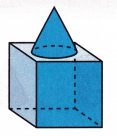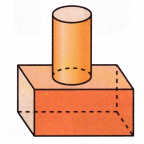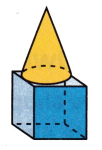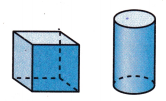All the solutions provided in McGraw Hill My Math Grade 1 Answer Key PDF Chapter 10 Lesson 4 Combine Three-Dimensional Shapes will give you a clear idea of the concepts.
McGraw-Hill My Math Grade 1 Answer Key Chapter 10 Lesson 4 Combine Three-Dimensional Shapes
Explore and Explain

cube
rectangular prism
cone

rectangular prism
cylinder
cube
Teacher Directions: Use geometric solids to make each composite shape shown. Circle the name of the shapes you used to make the composite shape.
Answer:
In the first shape they have used cone and a cube
In the second shape they have cylinder and a rectangular prism.
See and Show
You can put together three-dimensional shapes to make other composite shapes.

Circle the shapes used to make each composite shape.
Question 1.

Answer:

Explanation:
In this composite shape we have used
A cone, cylinder and a rectangular prism
Question 2.

Answer:

Explanation:
In this composite shape we have used
A cone a cube.
Question 3.

Answer:

Explanation:
In this composite shape we have used
A rectangular prism a cube and a cylinder.
Talk Math Will a cube stack on top of a sphere?
Answer:
No,
as the sphere has curved surface we cannot stack a cube on a sphere.
On My Own
Circle the shapes used to make each composite shape.
Question 4.

Answer:

Explanation:
In this composite shape we have used
Rectangular prism and a cylinder.
Question 5.

Answer:

Explanation:
In this composite shape we have used
A cylinder and a sphere.
Question 6.

Answer:

Explanation:
In this composite shape we have used
A rectangular prism and 2 cubes
Circle the shape that is not used to make the composite shape shown.
Question 7.

Answer:

Explanation:
In this composite shape we have used
a sphere and a cone.
Problem Solving
Question 8.
How many faces are there in all on the composite shape shown?

______________ faces
Answer:
7 faces
Explanation:
A cone has one face and a cube has 6 faces
1 + 6 = 7
so, the composite shape has 7 faces.
Question 9.
Circle the shapes that have two or more faces.

Answer:

Explanation:
A cylinder has 2 faces
cube and rectangular prism has 6 faces each.
HOT Problem Angie built this composite shape. Describe another composite shape she can build using these shapes.

Answer:
she can stack a cylinder first then a cube and at last a sphere.
McGraw Hill My Math Grade 1 Chapter 10 Lesson 4 My Homework Answer Key
Practice
Circle the shapes used to make each composite shape.
Question 1.

Answer:

Explanation:
In this composite shape we have used
A cylinder, cone and a rectangular prism.
Question 2.

Answer:

Explanation:
In this composite shape we have used
A cylinder, cube and a rectangular prism.
Circle the shape that is not used to make each composite shape shown.
Question 3.

Answer:

Explanation:
In this composite shape we have used
A cylinder, cube and a rectangular prism.
Question 4.

Answer:

Explanation:
In this composite shape we have used
A cylinder, cone and a rectangular prism.
Question 5.
I am made up of 2 three-dimensional shapes. One of my shapes has 1 face. The other shape has 2 faces. Circle the 2 shapes.

Answer:

Explanation:
A cone has one face and a cylinder has 2 faces
so, circled cone and a cylinder.
Test Practice
Question 6.
How many faces do a cube and cylinder have in all?

(A) 2
(B) 4
(C) 6
(D) 8
Answer:
8 faces
Explanation:
A cube has 6 face and a cylinder has 2 faces
2 + 6 = 8
so, there are 8 faces in all.
Math at Home Have your child find different three-dimensional objects in your house. Have them build new composite shapes with these objects. Have them tell you which shapes they used to create the new composite shapes.
Answer: Yes they are able to identify the shapes like Rubix cube, chocolate, ice cubes.